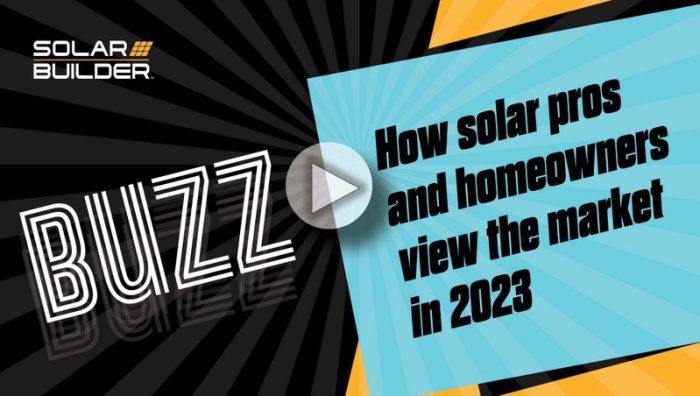
On the latest edition of Solar Builder Buzz, Editor-in-Chief Chris Crowell is joined by Sarah Kim, VP of marketing at Aurora Solar, to discuss their Solar Industry Snapshot, which included data from their database of over six million projects, a survey of 1, 000 U.S. homeowners and a pulse check of nearly 1,000 U.S. solar pros. In it, we discuss…
0:45 – How did the survey findings compare to other forecasts?
1:20 – The imbalance between consumer interest and installation numbers
2:35 – How to capitalize on interest and reduce reluctant leads
4:45 – Main drivers of solar interest (and managing the sticker shock)
6:39 – Customers worried about illegitimate installers – how to assure you are legit
9:16 – Top homeowner perceptions of solar, and how to market around those
11:18 – How to lead in an immature solar market
13:00 – Generational differences in customers
15:46 – Final survey takeaway
Watch the full 15-min chat or read part of our conversation below.
Crowell: Twenty-two percent of installers you surveyed say ‘homeowners being reluctant to commit to quotes’ is one of their biggest problems. So, you have high demand and a lot of front-end work that ultimately fizzles out. That stinks, obviously, for installers. Is there anything that stood out as a meaningful opportunity for solar installers to capitalize on that interest and lower that percentage of reluctant leads?
Kim: There are a number of things that installers can do to make sure that journey is easy for the homeowner so that ultimately they will convert to paying customers. I think it is incredibly important at this time for installers to do their own legwork to make sure that they line up multiple financing options, so they show up at the table with the ones that are best in line with the homeowner. What are they looking for? Is it a zero-dollar-down? Are they looking for ultimately lower monthly payments? …
Crowell: Another standout number to me is half of homeowners’ biggest concern is determining if an installer is legitimate. How can legitimate installers appear legitimate?
Kim: It is an unfortunate perception problem. I would say this number in fact is even larger for certain populations. Specifically among baby boomers that number is actually as high as 60%.
To your point about this legitimacy problem, a lot of homeowners feel like this outreach that they get from a lot of the solar companies in their neighborhood feels like spam, you know? It is absolutely critical for this industry to be able to scale to overcome these signals that we are sending out there.
How do they do this? Well, I don’t know that I have any magic bullet. This may sound like a marketer answer, but the things that have worked for so many other businesses in the digital space will work in this industry as well. Can you imagine 10 years ago that we were going to use Airbnb and stay at some stranger’s home? It’s crazy, right? How do we get over that? Well, we did it by being very forthcoming with information and making it very obvious. Have a digital presence that has easy to find contact information — really basic things — and having a few reviews from homeowners in the surrounding area.
There are some other things that they could do to boost their digital presence, but beyond that I think there’s still a lot of human elements in this business. It is very much a local business, which I think is very helpful for the smaller installers. They may feel like ‘hey, I don’t have a national presence or the big budgets to go and do advertising,’ but having validation from a handful of homeowners that have seen good work from your business and making sure that it shows up in every touch point along the customer journey is super important.
Crowell: The report also got into homeowner perceptions of solar — some of which are misconceptions, like 34% thinking solar panels are less efficient in winter. When you were looking over those data points, did anything stand out as maybe an opportunity for solar installers to market in a different way?
Kim: There’s still so much opportunity for education in this space. Installers are as close as it comes to being that coach for the homeowner. Throughout this journey, they need to be able to walk in with confidence, with data and credible sources of information, from organizations like SEIA.
Homeowner education is the other piece of this entire experience that is now digital. We are seeing, especially over the pandemic, there has been an evolution toward homeowners wanting to consume more services and products through a digital experience, and that gives installers incredible power to be able to not just show up with the final quote but really walk them through that entire process. ‘Hey, this is where the sun is throughout the day; here is how it moves; here is what the numbers show; let me show you a chart with how much you are paying today and how that is going to evolve over time.’ There is an incredible opportunity to have a teaching moment in every stage of this buying cycle.
Pick up the conversation right there:
— Solar Builder magazine

Leave a Reply
You must be logged in to post a comment.